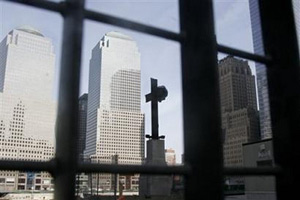 |
 |
 |
 Travel Writers' Resources | May 2006 Travel Writers' Resources | May 2006  
The New York Times Cover-Up Continues
 Carl Pope - HuffingtonPost.com Carl Pope - HuffingtonPost.com


| | A cross formed by beams from the original World Trade Center is visible through a fence surrounding the World Trade Center site in New York. The foundation in charge of developing ground zero's memorial and museum pledged to permanently display the two pieces of steel left standing in the shape of a cross after the World Trade Center collapsed. WTC Memorial Foundation President and CEO Gretchen Dykstra agreed to find a place for the artifact at the site, though acknowledged it's a delicate issue and viewers should be allowed to draw their own conclusions about whether it has religious significance. (AP/Peter Morgan) |
It's been four and a half years since the attack on the World Trade Center. The death toll continues to rise.

But now those who die are victims of their own government's recklessness and dishonesty - not Al Qaeda's hatred. The New York Times has finally come back and laid out the painful story of the deaths and health impacts on those who were first responders, rescuers, or involved in the cleanup after the attack. The Times admits that "The ailments now seen are far more serious than the general hacking and congestion known as 'World Trade Center cough' that initially hit most responders. Rather, these are a set of diseases and disorders that typically take a few years to develop, and in some cases get progressively worse."

But this latest article continues the pattern - the Times will not tell its readers that the recklessness that characterized the Bush administration's response to the health threats involved in the Ground Zero cleanup have never been acknowledged by the Administration as a mistake but have instead been made official U.S. government policy in the case of the next terrorist attack.

The Administration's priorities on and after 9/11 were to calm public fears and to get Wall Street up and running - not to protect either first responders or residents. Based on the Department of Homeland Security's new guideline for cleaning up radiological contamination in a national emergency (Federal Register Vol. 71, No. 1, p. 174), it appears that it is now official U.S. government policy that in the event of another terrorist attack, the affected community will not be cleaned up and made safe if that cleanup would unduly disrupt the economy. (Similar short cuts were taken with the public health after Katrina on the Gulf Coast.)

Ironically, on the same day, the Times also reported that demolition of the former Deutsche Bank building opposite Ground Zero had to be halted because of improper management of asbestos-related debris.

This was the second time that demolition work had to be halted. If you want a sense of how well the cleanup of Lower Manhattan was managed, take a look at the explanation the Times gave: "Last month, the rooftop cleanup was halted after a fragment of asbestos-containing material was found in the ballast. Hundreds of small fragments of human remains have also been found on the rooftop."

This issue has been covered by other media outlets - the Guardian, for example, laid the blame where it belongs - on the Bush administration's ignoring fundamental safety rules in managing the cleanup. The whole story is also documented in the Sierra Club Chronicles feature, "9/11 Forgotten Heroes." But not the Times: America's newspaper of record has consistently refused to tell the whole story. Even when, as last week, it reports on the human toll, it refuses to provide the easily documented answer to the question "why?"

Because our government wants it that way, that's why. But why won't the New York Times report it? | 
 | |
 |



